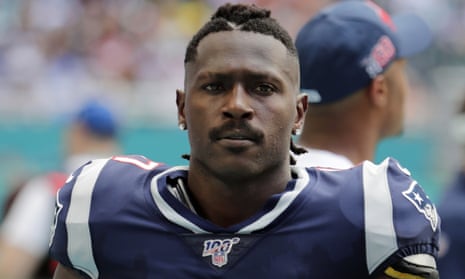In the hours following Friday’s announcement that wide receiver Antonio Brown was released by the New England Patriots amid mounting allegations of sexual misconduct only 11 days after signing with the team, the media served up a competitive play-by-play on his status. TMZ reported Brown “looking sad” as he touched down in Miami. CBS pondered “why the Patriots could be in trouble if things get any worse”. Iterations of “Brown out. What now?” sprouted up innumerably across the web. Brown, for his part, tweeted eight similar “thank you” messages to the Patriots for the opportunity and a “Just got fired on Friday” with a facepalm emoji. A sizable chunk of the thousands of comments in response to his posts invoked God and prayer for Brown’s resolve to stay strong and keep fighting. He capped off his thread with a photo sitting on the hood of a Rolls Royce in front of a private jet, with the caption: Beat the odds.
Brown will not face criminal charges for the accusations leading to his dismissal, including most notably one of rape in a civil lawsuit by his former trainer, Britney Taylor (Brown has denied the allegations). He took again to Twitter on Sunday morning to answer the headlines’ musings himself. He said he was quitting the NFL and took shots at Patriots owner Robert Kraft and his former teammate Ben Roethlisberger. Earlier this week, Taylor spent 10 hours in discussion with the NFL investigation team going over her lawsuit. Her social media profiles have been wiped clean.
This Friday will mark the one-year anniversary of Palo Alto University professor Christine Blasey Ford testifying before Congress about the sexual misconduct of then-nominee, now-sitting associate justice of the US supreme court, Brett Kavanaugh, when they were both in high school.
Much of the current related media coverage is, like that of Brown, Kavanaugh-centered – on the fallout from the publication of The Education of Brett Kavanaugh, the New York Times’ woeful lapse in judgement when describing a second accuser, the ensuing correction, the President’s defense of Kavanaugh – the list goes on. Part of what has been lost in the swirl of this news cycle is the notion that through the act of testifying, Ford offered a platform to even have these kinds of conversations. The problem is, she hasn’t been included in any of them. The conversations happening now, one year after her coming forward and more than 30 years after the alleged assault, have to do with the man she accused: his actions, his character, his politics, his career.
I watched Ford’s testimony on my laptop at work. Watching her face, her movements – this wasn’t the testimony of an emboldened, empowered woman. This wasn’t a warrior, a fighter, or any of the other trite stereotypes used to label women advocating for themselves. This was a professional woman, uncomfortable and subject to profound misinterpretation and condemnation on a very public stage, who was coming forward anyway.
One of the problems with conversations around sexual misconduct, and abuse, is that we tend to oversimplify the takeaways. We compress the narratives to soundbites: Did it happen or not? Can you remember every precise detail? Yes or no? It is stripped of the painfully complicated nuances it entails, of the deep ambivalences, ambiguities and contradictory feelings that can result when the assailant is a known acquaintance. We don’t have enough of a safety net in place for these kinds of discussions to unfold post-disclosure, to cushion the aftershock of ongoing criticism and doubt. The alleged victim appears, discloses and is chased out of the public eye in a cloud of Twitter outrage. The news cycle and our attention moves on.
For now, Brown remains in limbo under ongoing NFL investigation. But there is a sense of process taking place, legal formalities that will help his story move forward. What is unclear is whether these events will yield a wider cultural understanding of how to care for victims after the disclosure, or whether the headlines will peak, fizzle and dry out. Today, it is still Brown’s future we’re waiting to hear about, not Taylor’s.
